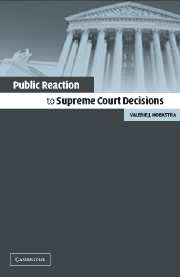Book contents
- Frontmatter
- Contents
- List of Figures
- List of Tables
- Acknowledgments
- 1 The High-Wire Act: The Supreme Court and Public Opinion
- 2 From the Marble Temple to Main Street: Placing the Cases in Political and Legal Context
- 3 Media Attention and Public Awareness
- 4 Changing Hearts and Minds? Examining the Legitimation Hypothesis
- 5 Public Support for the Supreme Court
- 6 Conclusion: Balancing Independence and Support
- Appendix A Sampling
- Appendix B Survey Instruments Included in the Analysis
- Appendix C Local and National Media Coverage of a Sample of Supreme Court Cases: 1996–97 Term
- Appendix D Statistical Issues with the Analysis of Panel Data
- References
- Index
3 - Media Attention and Public Awareness
Published online by Cambridge University Press: 02 September 2009
- Frontmatter
- Contents
- List of Figures
- List of Tables
- Acknowledgments
- 1 The High-Wire Act: The Supreme Court and Public Opinion
- 2 From the Marble Temple to Main Street: Placing the Cases in Political and Legal Context
- 3 Media Attention and Public Awareness
- 4 Changing Hearts and Minds? Examining the Legitimation Hypothesis
- 5 Public Support for the Supreme Court
- 6 Conclusion: Balancing Independence and Support
- Appendix A Sampling
- Appendix B Survey Instruments Included in the Analysis
- Appendix C Local and National Media Coverage of a Sample of Supreme Court Cases: 1996–97 Term
- Appendix D Statistical Issues with the Analysis of Panel Data
- References
- Index
Summary
Most of the Court's decisions do not attract widespread public attention. Most people find it remote and confusing or identify only with its institutional symbols.
– O'Brien (1986, 297)Perhaps the best example of the public's ignorance of the Court was a 1989 Washington Post survey. Nine percent correctly named William Rehnquist as Chief Justice of the United States. Among associate justices, recall ranged from 23 percent for Sandra Day O'Connor, to .6 percent for John Paul Stevens. All this pales by comparison with 54 percent who correctly named Joseph Wapner as the judge on the TV show ‘The People's Court.’
– Segal and Spaeth (1993, 353)INTRODUCTION
When the Supreme Court entered into the 2000 presidential election, it placed itself in the middle of one of the most heated political debates in recent memory. While most citizens could probably not explain the subtleties of the legal arguments, virtually everyone knew the decision would ultimately determine the outcome of the election. The reason why the electorate was so well informed is simple: For weeks, the Court's decision was featured in the morning newspaper, on the television evening news, or on the car radio during the morning commute. The Court's decision simply saturated the media, and consequently, people across the nation were interested in the Supreme Court. Many Americans also know of the Court's involvement in other controversial issues such as abortion, school desegregation, and flag burning.
- Type
- Chapter
- Information
- Public Reaction to Supreme Court Decisions , pp. 51 - 86Publisher: Cambridge University PressPrint publication year: 2003

